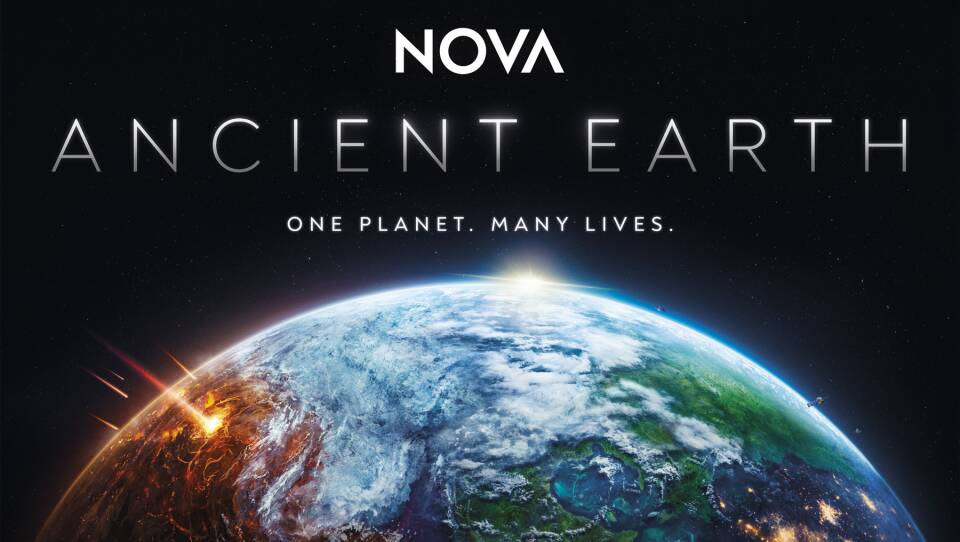The new NOVA series Ancient Earth gives viewers a mesmerizing look at what Co-Executive Producer Chris Schmidt calls Earth’s “baby pictures.” The epic story of the planet, from its birth to the emergence of humanity, told through dazzling animation and the latest research, showcases the most dramatic events in Earth’s history.
How did a hellscape of molten lava transform into a lush, green, watery planet filled with life?
“A lot of people think of the history of Earth and of life as kind of a straight line, an upward- rising, ever-expanding, inevitable climb to a pinnacle that is us,” said Co-Executive Producer Julia Cort. “Ancient Earth tells us this is not a straight line. It is full of drama, full of ups and downs.”
A BBC Studios Production with NOVA for PBS and the BBC, the five-part series, with its original animation and musical score, premiered on GBH 2 on Wednesday, October 4 with new episodes broadcast through Nov. 1. They make for sumptuous viewing.
“The series is full of incredibly beautiful, detailed and accurate graphics that immerse the audience in these amazingly weird environments that scientists have been able to envision,” said Cort. “It shows us ancient Earth like we’ve never seen it before,” added NOVA Senior Producer Caitlin Saks. “And evocative music helps convey the drama of what these big geologic events mean.”
Ancient Earth draws on the deep science expertise of more than 50 advisors and scientists and features interviews with a diverse, younger cadre of experts. “The series does a wonderful job of showcasing a really impressive diversity of scientists—all of whom radiate their passion for discovery. They invite us into these almost alien versions of Earth and share their wonder. They’re like ambassadors of awe,” said Schmidt.

The films are full of surprises, including tree-high fungi towering above the Earth before the arrival of plants, a planet almost completely encased in ice 700 million years ago and the volcano-induced mass extinction of 90% of all species on Earth 252 million years ago. “People are familiar with events like the asteroid wiping out the dinosaurs, which allowed mammals to thrive, but there are a lot more accidents or happen- stances that are much less celebrated that actually were super important,” said Schmidt.
“Each film is about a chapter of Earth’s history that people don’t usually think about,” said Saks. “In Episode Four ‘Inferno,’ for example, there was volcanism that was so effusive, it was like a Krakatoa erupting every year for 300,000 years.”
“The series gives you that perspective of deep time and constant change,” said Schmidt. “That is really interesting and humbling.”
Episodes are focused on the prehistoric geology that created the environment we have today, said Saks. “That gives you an appreciation for the moment that we’re living in, the fragility of the moment that we’re living in. It also gives you an appreciation for the series of extraordinary events that had to have happened for humans to have evolved and how unlikely our existence is.”
The constancy of geologic change suffuses the films. “I think viewers will come away from the series with a new understanding that climate change is a constant feature throughout Earth’s history–and while Earth always persists, there have been times when life on Earth has been pushed to the brink. It’s an important lesson,” said Schmidt.
“The intricacies of this story will fascinate people,” said Cort. “And the fact that we humans can figure out what was happening on the planet four billion years ago—that in itself is awe-inspiring.”
Five Epic Episodes
With spectacular animation based on the latest scientific research, each of Ancient Earth’s five episodes brings to life long-lost worlds that ultimately led to the one we know today.
Episode 1: “Birth of the Sky” shows how Earth transformed from a barren waste- land to a planet capable of sustaining life.
Episode 2: “Frozen” poses the question, how did life survive on a planet covered in ice from pole to pole?
Episode 3: “Life Rising” reveals how life made the leap to land, turning a desolate landscape into a lush, green world.
Episode 4: “Inferno” explores how life bounced back after a cataclysmic extinc- tion wiped out some 90% of all species.
Episode 5: “Humans” reveals how Earth gave rise to humans and what made our species’ existence possible.




